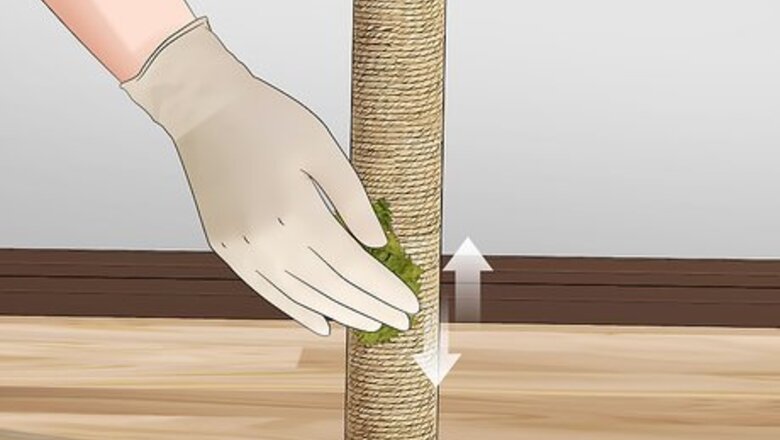
views
Encouraging and Rewarding Your Cat
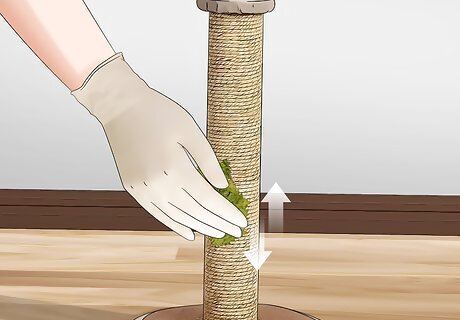
Rub fresh catnip on toys, scratching posts, and more to entice your cat. If you’re growing fresh catnip, snip off a handful of stems and leaves and rub them vigorously on scratching posts, new toys, cat carriers, and anything else you hope to draw your cat towards. You may need to repeat the process every 1-2 days to maintain the scent. Don’t rub fresh catnip on items more than once per day, though, because some cats can become desensitized to the scent if exposed to it all the time.
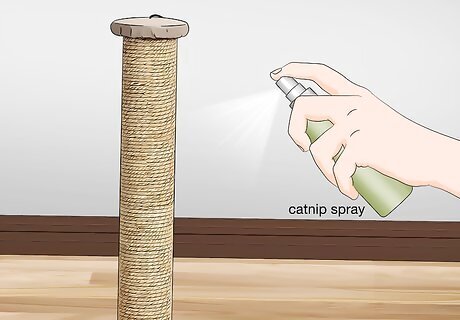
Spritz bottled or homemade catnip spray to draw your cat to items. If you don't have fresh catnip in your garden, this is an equally-great alternative. Buy bottled catnip spray at any pet store, or brew up some catnip tea for yourself and use the rest (once cooled) for your cat! Use the spray to add fragrance to scratching posts, toys, and so on. There's no need to douse items in catnip spray. A light mist from a few quick spritzes is plenty to any catnip-loving feline wild! As with fresh catnip, use the spray no more than once per day. Otherwise, your cat may become desensitized. Brew catnip tea by adding 15–20 g (0.53–0.71 oz) of fresh leaves or 5–7.5 g (0.18–0.26 oz) of dried catnip per 250 ml (8.5 fl oz) of boiling water. Steep it for 5-10 minutes. Store homemade the spray in the fridge for up to 3 days—it will start to lose its potency after that. Follow the package instructions for storage and potency if you're using bottled catnip spray.
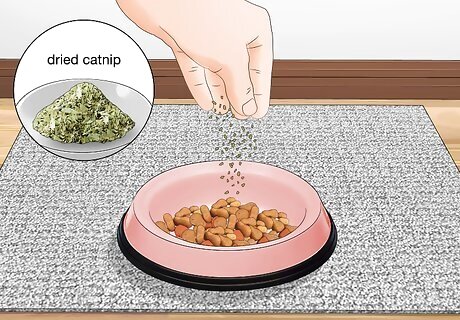
Add a pinch of fresh or dried catnip to food to get your cat to eat more. Tear 1-2 fresh catnip leaves into small strips, or sprinkle a pinch of dried catnip over your cat’s normal food. While the scent of catnip may inspire your fussy eater to dig in, actually eating catnip may cause them to “mellow out” for up to 30 minutes afterward! Don’t add more catnip than you would use to garnish a dish of human food. Too much catnip can cause diarrhea or vomiting in some cats. Keep in mind that up to half of all cats aren’t all that interested in catnip, so this may not work as a treat.
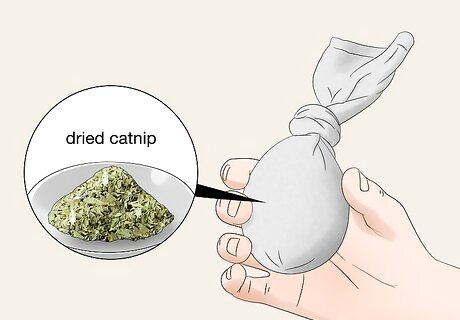
Tie dried catnip inside an old sock as a reward or comfort toy. Sure, you can buy cat toys that are made to be filled with catnip, but this works just as well. Stuff the foot of an old (but hole-free) tube sock with dried catnip, then tie off the top portion securely. If your cat loves catnip, it will go crazy for this simple toy! Offer the toy as a reward for good behavior, or as a comfort item when your cat is in a new environment (such as a friend's house) or stressful situation (like a trip to the vet). Let your cat have the toy for no more than about 30 minutes, once per day. Put it in a sealed container when your cat isn’t playing with it. This helps preserve the catnip scent and keeps your cat from becoming desensitized to it. Replace the dried catnip every 3 days or so.
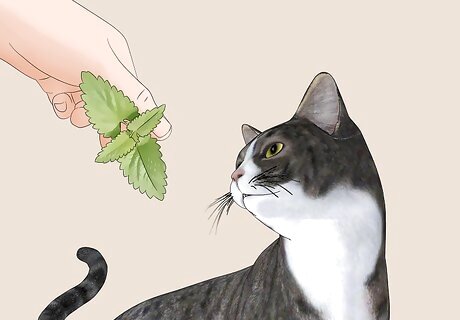
Reward your cat after training or for good behavior with 1-2 catnip leaves. Instead of giving a packaged kitty treat after a good training session, try using a fresh-plucked catnip leaf as a reward! To limit the chance of tummy troubles, don’t give your cat more than 1-2 leaves at a time, 2-3 times per week. Don't feed catnip to a pregnant cat, though, because it can cause reproductive complications.
Using Catnip Wisely
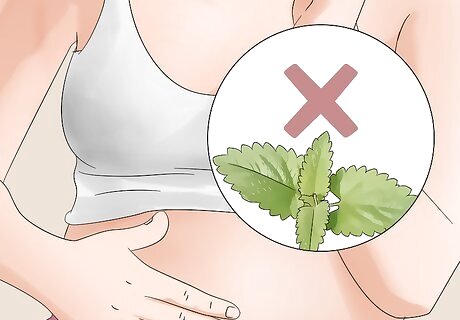
Don’t consume or apply catnip to your skin if you’re pregnant. For most people, catnip is safe to use and may provide a range of possible—but usually medically unproven—health and wellness benefits. If you are (or may be) pregnant, however, steer clear of using catnip, since there is some evidence that it may cause serious pregnancy complications in rare cases. For example, some people like to use catnip to make tinctures to apply to their skin for (medically-unproven) antibiotic or anti-inflammatory purposes. If you are pregnant, play it safe and avoid using or consuming catnip in any way.
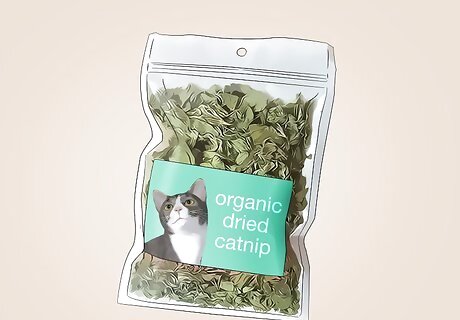
Don’t let a cat eat catnip that isn’t safe for consumption. If you buy dried catnip at the pet store, make sure it is listed as edible and does not contain unnecessary (and potentially harmful) ingredients. Many cat lovers stick with organic catnip if they intend to let their feline friend eat it. If you grow your own catnip, don’t use fertilizers or pesticides that aren’t clearly listed as food-safe. Don’t feed any type of catnip to pregnant cats, due to the risk of pregnancy complications (just as with pregnant women). Call your vet if your cat eats catnip that isn’t food-safe, if your pregnant cat eats catnip, or if any cat eats a large amount of catnip.
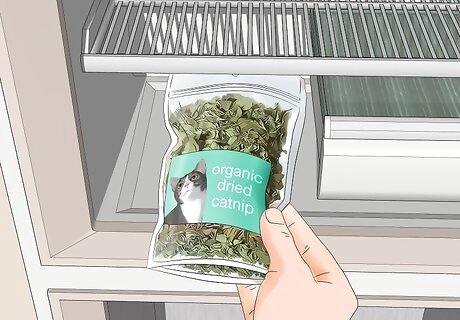
Store packaged or homemade dried edible catnip in the freezer. Dried catnip is typically inexpensive and widely available at pet supply stores. You may even find it at specialty (human) food markets! Dried catnip’s fragrance and flavor will last for 6-12 months if you stash the bag in the freezer. Alternatively, you can dry your own fresh catnip if you wish, following the same process used for another member of the mint family, basil. When frozen, it will likewise retain its fragrance and flavor for 6-12 months. Unfrozen, un-dried fresh catnip should be used immediately after harvest for the best results.
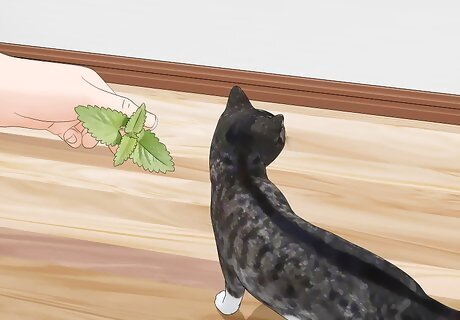
Don’t worry if your cat doesn’t seem to like catnip. It’s a myth that all cats go wild over catnip! In reality, only around 50%-70% of cats respond strongly to catnip. The other 30%-50% are either only mildly interested or totally indifferent to it. Catnip sensitivity seems to be an inherited trait that often runs in families. Kittens under 6 months of age (and especially under 3 months) typically don’t respond to catnip.
Utilizing Catnip for Food or Pest Control
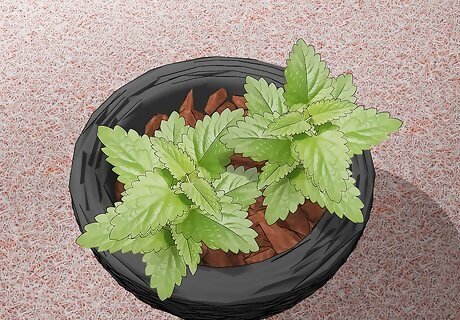
Grow catnip to add color and pest protection to your garden. You can grow catnip simply to enjoy its green color and minty fragrance. Or you can use it as a “companion plant” to keep pests like rabbits and rodents—which often don’t like the scent or flavor—away from your other plants. However, your garden may become very popular with the neighborhood cats! Catnip grows readily in a range of climates without much assistance. In fact, it spreads so rapidly that you may want to grow it in pots regardless of whether you’re keeping it indoors or outdoors. Catnip needs lots of sunshine—aim for at least 6 hours of full sun per day, unless you live in a very hot and dry climate. In that case, choose a spot that gets partial or shaded sunshine. Water the catnip only enough to keep the soil slightly moist.

Turn fresh catnip into a soothing evening tea. Pluck off a bunch of catnip leaves and add 15–20 g (0.53–0.71 oz) per 250 ml (8.5 fl oz) of boiling water. Steep the leaves for 5-10 minutes, depending on the strength of the brew you prefer. Remove the leaves, then add honey or sugar to taste, if desired. If you have a package of dried catnip, use 5–7.5 g (0.18–0.26 oz) per 250 ml (8.5 fl oz) of water. Add the dried catnip to a tea infuser ball or sachet, or strain it out of the tea when it’s done steeping. Many people find that catnip tea has a calming effect, much like chamomile tea.

Add fresh catnip to top off salads or main courses. Before dinner, snip off a small handful of stems and leaves. Snip the stems into 1 cm (0.39 in) pieces and add them to your salad, and tear or cut up the leaves to make a tasty garnish for your main course. Catnip has notes of both mint and lemon, so it goes great with a wide range of fish, meat, poultry, pasta, and other dishes. Catnip can be pungent in larger doses, so don’t add too much to your food. Eating more than a garnish-sized amount may also lead to gastrointestinal discomfort for some people.
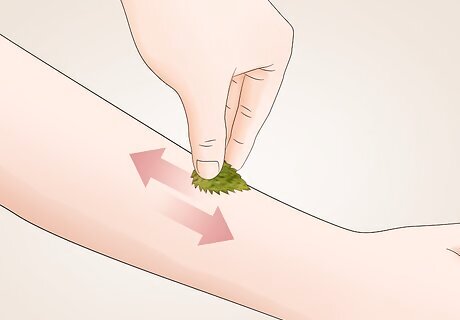
Rub fresh catnip on your skin as temporary bug-bite protection. While cats love its scent, the smell of catnip seems to repel unwanted critters such as mosquitoes. For some quick protection while working in the garden. cut off a handful of catnip and rub it vigorously over your exposed skin. You’ll probably only get 5-15 minutes of protection using this method, so either re-apply fresh catnip or get back inside before the mosquitoes pick up your scent!
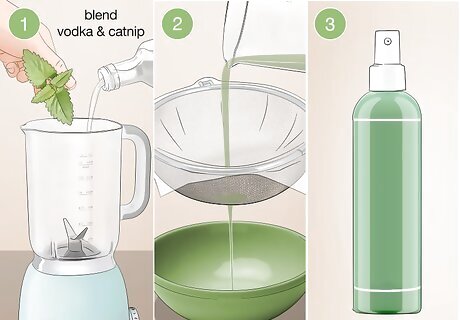
Make DEET-free mosquito repellent with catnip and vodka. Add a large handful of fresh-cut catnip stems and leaves to a blender or food processor. Pour in just enough plain (unflavored) vodka to cover the catnip, then blend the combination into a purée. Lay a kitchen cloth in a strainer placed over a bowl and pour the puree into the cloth. Fold up the cloth and squeeze the liquid into the bowl, then transfer it to a spray bottle. Shake up the bottle and spray it liberally on your exposed skin before going outside. You may get 30 minutes or more of protection. Alternatively, add 50 drops of catnip (nepeta cataria) essential oil per 125 ml (4.2 fl oz) of vodka.


















Comments
0 comment